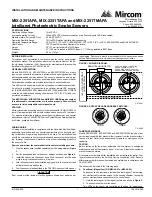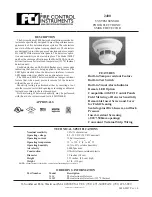
sor status. Coded signals, transmitted from the panel, can cause the
LEDs to blink, latch on, or latch off. Refer to the control panel technical
documentation for sensor LED status operation and expected delay to
alarm.
B. Smoke Entry: Aerosol generator (gemini 501)
The GEMINI model 501 aerosol generator can be used for smoke entry
testing. Set the generator to represent 4%/ft to 5%/ft obscuration as de-
scribed in the GEMINI 501 manual. Using the bowl shaped applicator,
apply aerosol until the panel alarms. Additionally, canned aerosol simu-
lated smoke (canned smoke agent) may be used for smoke entry testing
of the smoke detector. Tested and approved aerosol smoke products are
the Smoke Detector Tester model 25S available from Home Safeguard
Industries. When used properly, the canned smoke agent will cause the
smoke detector to go into alarm. Refer to the manufacturer’s published
instructions for proper use of the canned smoke agent.
CAUTION
Canned aerosol simulated smoke (canned smoke agent) formulas will vary
by manufacturer. Misuse or overuse of these products may have long term
adverse effects on the smoke detector. Consult the canned smoke agent
manufacturer’s published instructions for any further warnings or caution
statements.
For MIX-2251TMAPA, smoke entry testing should be performed imme-
diately following the magnet test. Magnet test initiates an approximately
10 minute period when the detector’s signal processing software rou-
tines are not active. Failure to first perform the magnet test will introduce
a time delay before the detector alarms.
C. Direct heat Method (hair Dryer of 1000-1500 watts) MIX-2251TAPA
and MIX-2251TMAPA only
A hair dryer of 1000-1500 watts should be used to test the thermistors.
Direct the heat toward either of the two thermistors, holding the heat
source approximately 12 inches from the detector in order to avoid dam-
aging the plastic housing. The detector will reset only after it has had suf-
ficient time to cool. Make sure both thermistors are tested individually.
A sensor that fails any of these tests should be cleaned as described under
CLEANING, and retested. If the sensor fails after cleaning, it must be re-
placed.
When testing is complete, restore the system to normal operation and notify
the proper authorities that the system is back in operation.
fIgURE 3. TEST MAgNET POSITION:
LED
TEST MAGNET
POSITION
MAGNET TEST
MARKER
LED
C0145-02
CLEANINg
Before removing the detector, notify the proper authorities that the smoke
detector system is undergoing maintenance and will be temporarily out of
service. Disable the zone or system undergoing maintenance to prevent un-
wanted alarms.
1. Remove the sensor to be cleaned from the system.
2. Remove the sensor cover by pressing firmly on each of the four removal
tabs that hold the cover in place.
3. Vacuum the screen carefully without removing it. If further cleaning is
required continue with Step 4, otherwise skip to Step 7.
4. Remove the chamber cover/screen assembly by pulling it straight out.
5. Use a vacuum cleaner or compressed air to remove dust and debris
from the sensing chamber.
6. Reinstall the chamber cover/screen assembly by sliding the edge over
the sensing chamber. Turn until it is firmly in place.
7. Replace the cover using the LEDs to align the cover and then gently
pushing it until it locks into place. Make sure that the thermistors do not
become bent under the cover on MIX-2251TAPA and MIX-2251TMAPA
models.
8. Reinstall the detector.
9. Test the detector as described in TESTING.
10. Reconnect disabled circuits.
11. Notify the proper authorities that the system is back on line.
fIgURE 4. SENSOR ASSEMBLy:
SENSOR
COVER
SENSING
CHAMBER
COVER AND
SCREEN
COVER
REMOVAL
TABS
SENSING
CHAMBER
OPTIONAL
THERMISTORS
(MIX-2251TAPA and
MIX-2251TMAPA)
C0215-02
SPECIAL NOTE REgARDINg SMOkE DETECTOR gUARDS
Smoke detectors are not to be used with detector guards unless the combina-
tion has been evaluated and found suitable for that purpose.
MC-400-006 2 I56-3319-000
©2008 Mircom
fCC STATEMENT
This device complies with part 15 of the FCC Rules. Operation is subject to the following two conditions: (1) This device may not cause harmful interference, and (2) this device must accept any interference
received, including interference that may cause undesired operation.
NOTE: This equipment has been tested and found to comply with the limits for a Class B digital device, pursuant to Part 15 of the FCC Rules. These limits are designed to provide reasonable protection against
harmful interference in a residential installation. This equipment generates, uses and can radiate radio frequency energy and, if not installed and used in accordance with the instructions, may cause harmful
interference to radio communications. However, there is no guarantee that interference will not occur in a particular installation. If this equipment does cause Harmful interference to radio or television reception,
which can be determined by turning the equipment off and on, the user is encouraged to try to correct the interference by one or more of the following measures:
– Reorient or relocate the receiving antenna.
– Increase the separation between the equipment and receiver.
– Connect the equipment into an outlet on a circuit different from that to which the receiver is connected.
– Consult the dealer or an experienced radio/TV technician for help.
This Class B digital apparatus complies with Canadian ICES-003.
Please refer to insert for the Limitations of Fire Alarm Systems




















